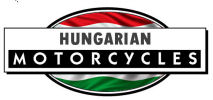




Csepel: 1928-2003
Csepel made motorcycles in Hungary from 1951-1975. They were sold under many other brand names including Danuvia, Tunde, Panni, & Pannonia. In the United States they were marketed under the White marque.
The Manfred Weiss Steel and Metal Works was renamed to Csepel Works after the Communist Party came to power in Hungary. The factory began producing bicycles in 1928 under the WM marque with the first motorcycles appearing in 1930 or 1931. These BMA style machines were built until 1935, and were followed by the 86cc Turan. Around 10,000 motorcycles were built prior to the destruction of Budapest by the Russians during WWII, which, after the country had swung to hard right politics, they entered on the side of the Axis powers. When the Germans occupied Hungary in 1944, the Weiss family avoided deportation to the death camps and escaped to Portugal, reportedly with the help of sympathetic Hungarian government officials. During the war the factory built engines for Messerschmitt.
Prewar models included the Csepel Red (1931), WM Nickel Tank 100cc (1937).
Production resumed after the war in 1947, with the introduction of the Csepel Tura 100, and by 1951 they were in full production, with some 50,000 mostly 125cc VM models constructed in 1951-1955.
Pannonia machines were built in another section of the WM works and produced 125cc and 250cc machines. These were released under both the Pannonia and Danuvia marques.
At this time the government was strongly pro-communist employing Stalinist policies which proved immensely wasteful and unpopular. In 1956 the people revolted, and were promptly crushed by Russian tanks. Control of the country fell to the Russians for the next 30 years, with predictable results.
Pannonia found a market in the Soviet Union, building and exporting around 40 thousand machines per year. These were quite good machines when introduced, but as no R&D work was done during the Soviet years the bikes were very dated by the 70s with the result that Western markets were uninterested in such antiquated machines even at greatly discounted prices. They produced a copy of the Yamaha YDS3/YM1 machine, but quality was such that it too failed dismally against the more expensive and vastly more reliable Japanese two-strokes.
In the early 70s new models were introduced, the Pannonia T5, P10 and P20, and later a P21 and P12. These were exported to Asia, Europe and the United States (as the White) with mixed reception.
The Pannonia factory entered a number of machines in Bol d'Or endurance races.
Pannonia ceased production in October 1975.
Csepel had continued to produce bicycles but their products too were on the wrong side of history, with much of their export going to Iran. The Schwinn firm took a commanding share in Csepel in 1989, but that company failed in 1993 and by 2003 Csepel had closed up shop.
Models and prices
Pannonia 1973 T5 with Duna sidecar, Frame no. T573022658. Sold in 2014 US$9700
Sources: okteamclassic.com, cold-war-racers.com, et al.
If you have a query about Csepel motorcycles please contact us